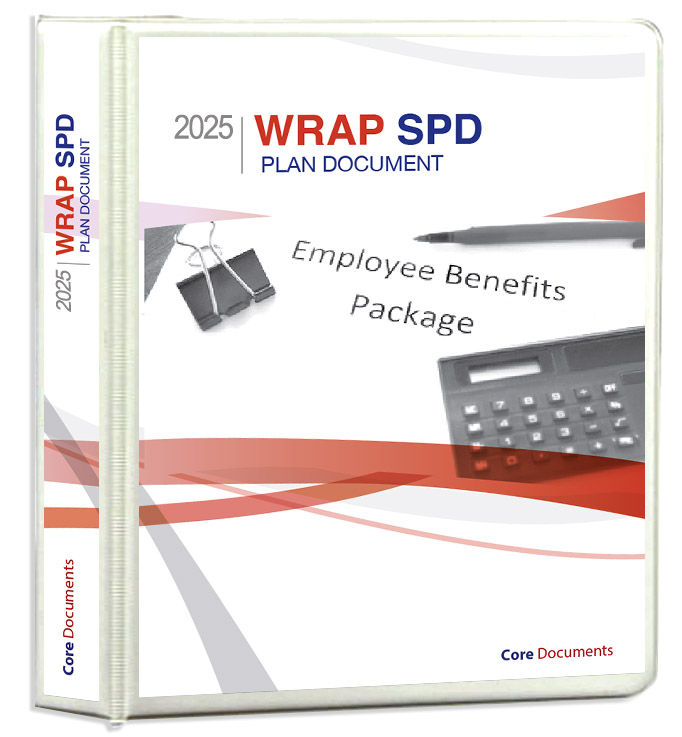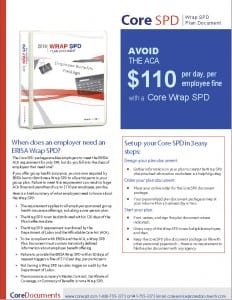ERISA Wrap SPD Plan Document just $149 one-time fee

Avoid the Affordable Care Act $110 per Day Fine with a Wrap SPD for Your Group Health Plan
$149 one-time fee in PDF via email*
$199 one-time fee in PDF email* + Deluxe Binder via USPS
The Wrap SPD is the main ERISA, DOL and now ACA mandated vehicle for communicating plan rights and obligations to employee participants and beneficiaries. As the name suggests, it is a summary of the material provisions of the plan documents, and it should be understandable to the average participant of the employer.
![]()
1-888-755-3373
ERISA, and now the Affordable Care Act require that any sponsor of group health insurance comply with certain disclosure requirements within the required Wrap SPD Plan Document.
Under ERISA the responsibility for issuing a Wrap SPD Plan Document rests with you, the Employer/Plan Administrator, and not with your health insurance carrier. Here’s what you need to know as succinctly as possible.
- If you offer group health insurance you’re now required by ERISA law, enforced by the Department of Labor and now the Affordable Care Act, to distribute a Wrap SPD Plan Document within 120 days of the Plan’s effective date.
- Failure to provide the Wrap SPD within 30 days of request triggers a $110 a day fine. Not having a Wrap SPD can also trigger an audit by the Department of Labor.
- The insurance company’s Master Contract, Certificate of Coverage, or Summary of Benefits is not a Wrap SPD.
- This requirement applies to all employer sponsored group health insurance offerings, including a one-person plan.
To be compliant with ERISA and the Affordable Care Act a Wrap SPD Plan Document must have certain statutorily defined specific information about the underlying group health plan that is specific to the employer benefit offering.
This required information is not contained in the Certificate of Coverage (benefit booklet) supplied by your health insurance carrier. Thus, your SPD must include one or more documents you prepare and adopt in addition to the documents provided by your carrier; the documents supplied by your group insurance carriers are not a sufficient SPD.
Also see: Employers must prepare an ERISA Wrap SPD to supplement the Certificate of Insurance
Because employers must provide this specific information to their employees in order to comply with ERISA, and now the Affordable Care Act, Core Documents now provides the Wrap SPD Plan Document.
When customized with your employer-specific information, and approved by your legal counsel, the resulting document could be used in conjunction with Certificate of Coverage, Member Payment Summary, and Provider & Facility Directory supplied by your insurance carrier to create a a compliant Wrap SPD Plan Document.
The necessary information contained in the final document will vary depending on the specific design and administration of your plan (of which your health insurance may just be a part) and the existence of other plan documents.
Video: Executive Summary of the Wrap SPD Plan Document Requirement
3:00 minutes
PDF Brochure – Core Wrap SPD Plan Document & Forms
Core Documents will notify you when there are sufficient changes in the Code to require amending and restating your Plan. You can amend and update anytime your benefit plan options change for just $149. You only amend the Wrap SPD when necessary which is the most cost effective way to establish and maintain a compliant Wrap SPD Plan Document.
*Most documents go out the same day via email within hours M-F. Orders placed on the weekend will be emailed Monday morning. Keep in mind that December, January, and February are our busiest months of the year and documents are processed in the order they are received. The Rush Order fee ($25) simply brings your document to the top of the stack to be processed immediately.
Health Care Reform – Notices/Disclosures (additional information)
Summary – The health care reform law makes many changes to health coverage requirements, such as extending coverage for young adults up to age 26, prohibiting rescissions of health coverage (except in cases of fraud or intentional misrepresentation), eliminating preexisting condition exclusions for children under the age of 19 (applicable to adults in 2014), prohibiting lifetime limits on essential health benefits and restricting annual limits, and requiring coverage for preventive care without cost-sharing. The law has staggered effective dates. Many of its changes are effective now, and others will become effective in future years.
Notices/Disclosure – The health care reform law created a number of notice and disclosure obligations for group health plans, such as:
Statement of Grandfathered Status – Plan administrator or issuer was required to provide the first statement before the first plan year beginning on or after Sept. 23, 2010. The statement must continue to be provided on a periodic basis with participant materials describing plan benefits. This requirement only applies to grandfathered plans.
Notice of Patient Protections and Selection of Providers – Plan administrator or issuer must provide a notice of patient protections/selection of providers whenever the summary plan description (SPD) or similar description of benefits is provided to a participant. These provisions relate to the choice of a health care professional and benefits for emergency services. The first notice should have been provided no later than the first day of the plan year beginning on or after Sept. 23, 2010. This requirement does not apply to grandfathered plans.
Documenting method for Identifying Full-time Employees
Beginning in 2015, the Affordable Care Act (ACA) imposes a penalty on applicable large employers (ALEs) that do not offer health insurance coverage to substantially all full-time employees and dependents. An ALE may also be subject to a penalty if it offers health insurance coverage to full-time employees and dependents, but the coverage is unaffordable or does not provide minimum value. An ALE is only liable for a penalty if one or more of its full-time employees receives a health insurance subsidy for coverage under an Exchange.
The ACA’s employer penalty rules are often referred to as “employer shared responsibility” or “pay or play” rules. The pay or play rules will take effect for many ALEs on Jan. 1, 2015.
This Legislative Brief includes a brief overview of the two methods for identifying full-time employees, and it provides guidelines for documenting the method an employer decides to use. It also includes sample language for describing the look-back measurement method. This sample language, which requires customization, could be incorporated into an employer policy, health plan document or summary plan description (SPD).
Methods for identifying Full-time Employees
On Feb. 12, 2014, the Internal Revenue Service (IRS) published final regulations on the employer shared responsibility rules. The final regulations provide two methods for identifying full-time employees for purposes of offering health plan coverage and avoiding a pay or play penalty—the monthly measurement method and the look-back measurement method.
A full-time employee is an employee who was employed, on average, at least 30 hours of service per week. The final regulations treat 130 hours of service in a calendar month as the monthly equivalent of 30 hours per service per week.
Monthly Measurement Method
The monthly measurement method involves a month-to-month analysis where full-time employees are identified based on their hours of service for each calendar month. This method is not based on averaging hours of service over a prior measurement period. Month-to-month measuring may cause practical difficulties for employers, particularly if there are employees with varying hours or employment schedules, and it could result in employees moving in and out of health plan coverage on a monthly basis.
Look-back Measurement Method
To give employers flexible and workable options and greater predictability for determining full-time employee status, the IRS developed an optional look-back measurement method as an alternative to the monthly measurement method.
Under the look-back measurement method, an employer counts an employee’s hours of service during one period (called a measurement period) to determine his or her full-time status for a future period (called the stability period). The details of this method are complex, and vary based on whether the employees are ongoing or new and whether new employees are expected to work full time or are variable, seasonal or part-time employees.
Latest Blog Posts
- HRA Plan Document Options Available in 2025 For Just $199
- ERISA Wrap SPD Compliance and Plan Design Expert Standing By
- Section 125 Premium Only Plan Document Design Consultants Standing By
- Section 127 EAP Educational Assistance Program & Student Loan Relief plan document
- What the ERISA Wrap SPD must communicate to employees
- ERISA Wrap SPD Plan Document just $149 one-time fee
- President Trump - Please Pass Proposed Executive Order 13877 health care sharing ministry as a medical care expense under section 213(d)
- Tax-free Employee Benefit Plan Document 2025 Brochures
Categories
- Brochure
- COVID-19
- Excepted Benefit HRA (EBHRA)
- Featured Videos
- Group Insurance Wrap SPD
- Health FSA
- Health Reimbursement Arrangements HRA Plans
- Health Savings AccountsHSA Plans
- Individual Coverage HRA (ICHRA)
- Latest Video
- PPACA , ObamaCare and Section 125 & HRAs
- QSE-HRA
- Qualified Small Employer HRA
- Section 125 Cafeteria Plans
- Section 127 Educational Assistance
- Section 129 Dependent Care Assistance Plan (FSA)
- Transit & Parking Qualified Transportation Fringe Benefit
- Uncategorized
- Video

